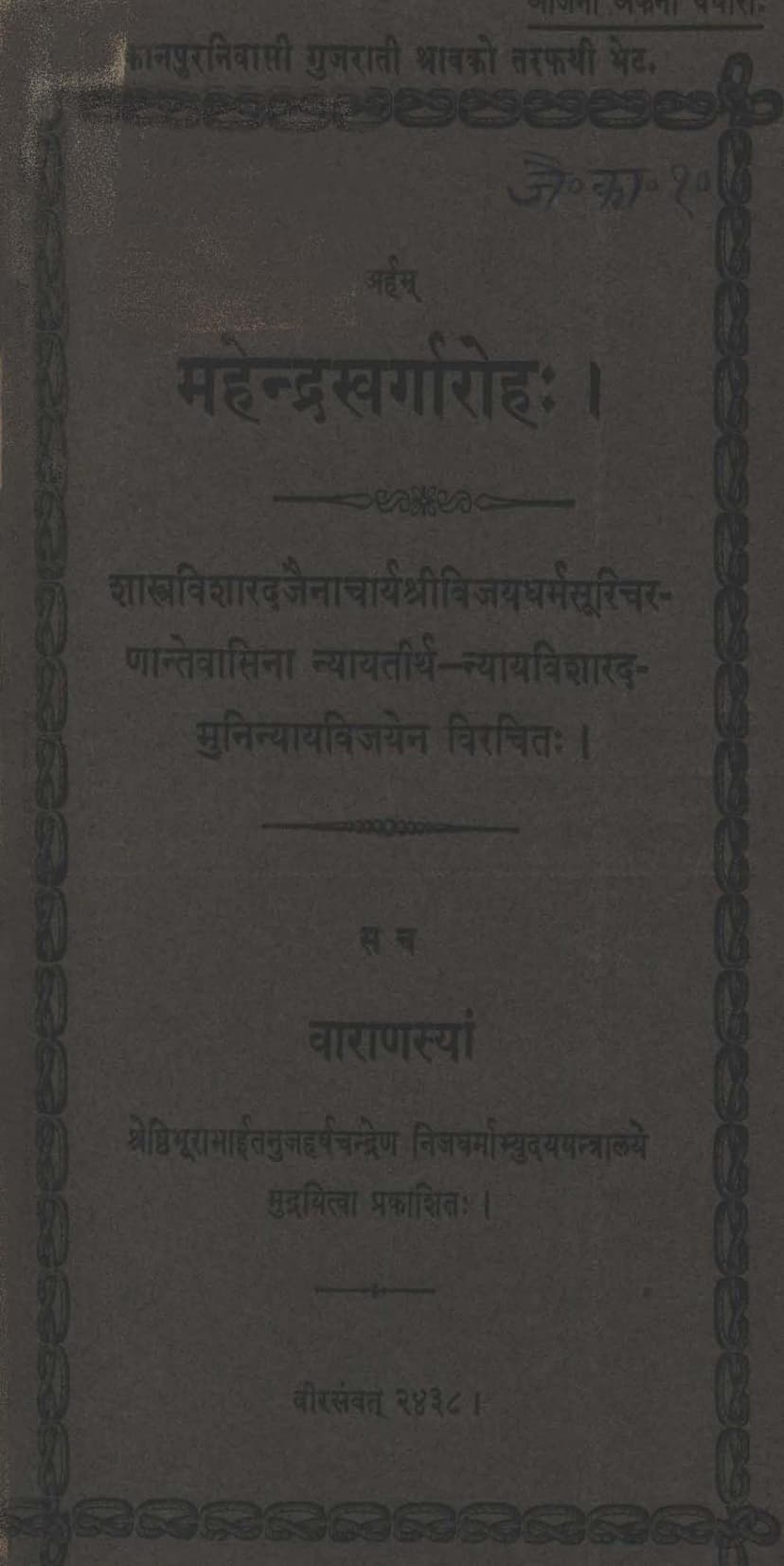Mahendraswargaroha
Added to library: September 2, 2025

Summary
Here's a comprehensive summary of the Jain text "Mahendraswargaroha" by Nyayavijay, based on the provided pages:
Title: Mahendraswargaroha (The Ascent to Heaven of Mahendra) Author: Munin Nyayavijay (disciple of Acharya Shri Vijaydharmasuri) Publisher: Gujarati Shravako (Jain lay followers) Publication Details: Printed and Published by Shah Harakholand Bhurabhai at the Dharmabhyudaya Press, Benares City, Vir Samvat 2438.
Overview:
"Mahendraswargaroha" is a biographical work that chronicles the life and spiritual journey of a revered Jain monk named Mahendravijay. The text highlights his exemplary character, his deep knowledge of scriptures, his ascetic practices, and ultimately, his peaceful departure from the mortal world, referred to as his "ascent to heaven." The work is a tribute to his virtues and serves as an inspiration for spiritual seekers.
Key Themes and Content:
The text is structured as a narrative poem, describing various aspects of Mahendravijay's life and spiritual qualities.
- Introduction and Tribute: The book begins with salutations to his Guru, Shri Vijaydharmasuri. It immediately introduces Mahendravijay as a great soul, a profound scholar, a compassionate and virtuous monk.
- Character and Virtues: The bulk of the text is dedicated to elaborating on Mahendravijay's character. He is depicted as:
- Devoted to Jainism: Deeply rooted in the Jain faith and teachings.
- Eloquent and Wise: Possessing eloquent speech, a sharp intellect, and deep knowledge of Shastra (scriptures) and Sahitya (literature).
- Compassionate and Kind: Characterized by kindness, possessing the qualities of a great ascetic (Mahatma).
- Humble and Disciplined: Living a life of discipline, adhering to vows, and practicing austerities.
- Patient and Peaceful: Demonstrating immense patience, control over his senses, and an inability to be provoked by harsh words. He is described as finding peace in forbearance.
- Detached from Worldly Desires: Unattached to material possessions, luxurious living, or worldly fame. He was content with what little he had and lived a simple life.
- Ascetic and Devoted to Study: Practicing rigorous austerities, such as eating only one meal a day (Ekaashan Vrata), and dedicating himself to scriptural study in solitude.
- Truthful and Sincere: Adhering to truth and sincerity in all his actions and words.
- Non-violent and Pure: His conduct was pure, and he embodied the principle of non-violence.
- Devoted to his Guru: Showing great respect and devotion to his spiritual master.
- Possessing Inner Peace: He was not swayed by passions or afflictions, finding solace in his inner strength and devotion.
- Life Events and Journey: The narrative also touches upon specific events in his life:
- Birth and Early Life: His birth in the Mandvi region of Gujarat, to devout parents, Shankalachandra and Jhaveriben.
- Education: His initial education and then his journey to Kashi (Benares) to study under Shri Vijaydharmasuri. He mastered various subjects, including grammar, literature, and logic.
- Spiritual Progression: His journey from worldly life to spiritual pursuit, eventually taking diksha (initiation) along with four other companions.
- Wandering and Teaching: His travels and teachings, spreading the Jain dharma, notably in Kashi and Calcutta.
- Physical Description: The text includes a detailed and poetic description of his physical appearance, highlighting his beauty, grace, and divine aura.
- The "Ascent to Heaven" (Swargaroha): The latter part of the text describes his final days. He is described as falling ill with a fever in Karnpur. Despite his suffering, he maintained his composure and devotion. The text poetically describes his passing as an "ascent to heaven" (Swargaroha), emphasizing the peaceful and dignified nature of his departure, achieved through his spiritual merits.
- Grief and Remembrance: The text conveys the deep sorrow and sense of loss felt by his disciples and followers upon his passing. There is a lament for his absence, but also a recognition of the impermanence of worldly life and the ultimate goal of spiritual liberation.
- Concluding Thoughts: The work concludes with a reaffirmation of his spiritual achievements and the enduring impact of his life and teachings. The author, Nyayavijay, expresses his admiration and offers prayers for Mahendravijay's continued spiritual progress.
Literary Style:
The text is written in a highly ornate and poetic Sanskrit style. The language is rich with metaphors, similes, and elaborate descriptions, creating a devotional and reverential tone. The author uses extensive vocabulary and complex sentence structures to praise the virtues of Mahendravijay.
Significance:
"Mahendraswargaroha" serves as a hagiographical account, celebrating the life of a significant Jain monk. It provides insights into the ascetic practices, philosophical underpinnings, and devotional spirit prevalent within the Jain tradition. The detailed portrayal of Mahendravijay's character aims to inspire readers to cultivate similar virtues and strive for spiritual liberation. The book is a valuable contribution to Jain literature, preserving the memory and teachings of a revered spiritual leader.